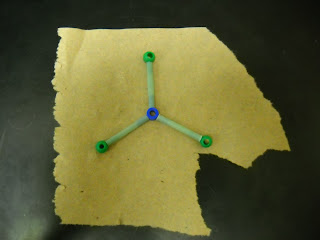Title:
Polarity and Molecular Shape LAB
Statement of the Problem:
1. Construct models of molecules
2. Determine molecular shapes
3. Predict polarity of molecules
Materials:
Molecular model Kit
Procedure:
In this lab we built a 3-dimensional model for every molecule , after constructing the models we drew a 3D representation, using different lines to represent the different directions of the bonds and types of bonds.
Results:
This is a table of the molecular formula, shape of molecule, bond angle, whether or not it has polarity, and if it is a resonance structure.
Analysis Questions:
1) Explain how water's shape causes it to be polar.
The electrons are pulled toward the more electronegative atom in the molecule. In water's case it is oxygen that is the most electronegative and since the bonds with the two hydrogen atoms form an angular molecule it leaves the side with oxygen's full valence orbitals exposed so hydrogen's exposes positive nucleus and oxygen's exposed electrons makes it a very polar molecule.
2) Describe how water's properties would be different if the molecules were linear instead of bent.
If water was linear there would be no exposed sides (thus symmetrical) and the electrons wouldn't accumulate toward any one side.
3) Based on the results of this experiment. List the molecules from the expirement that would be water-soluble.
C3H8, Si2H6, HF, H2O2, IF3, SF6, SO32-











